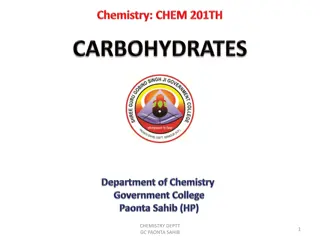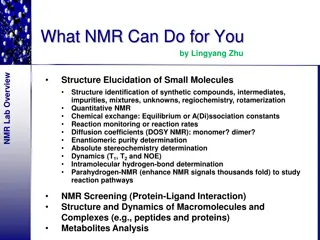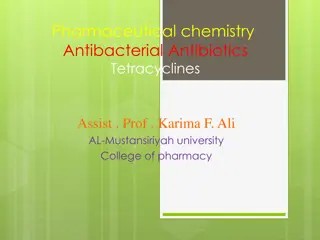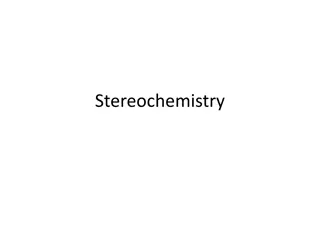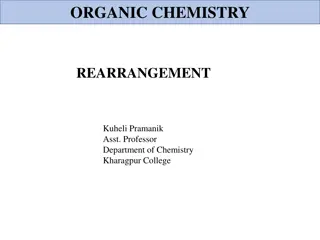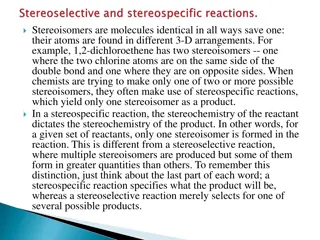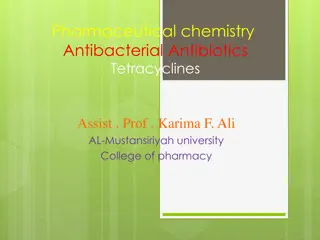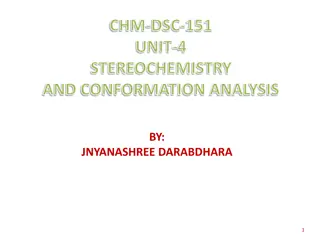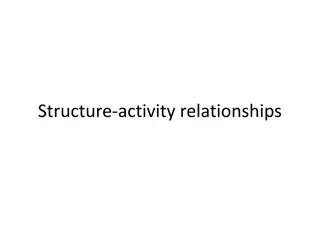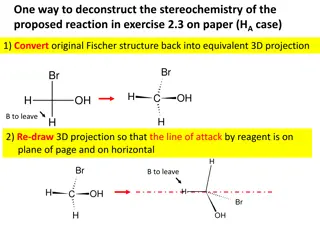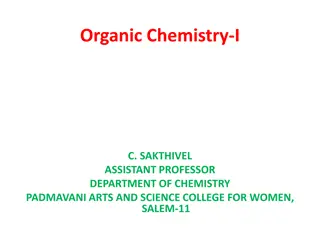
Stereoisomers, Chirality, and Projections in Chemistry
Learn about compounds with the same molecular formula but different structures like stereoisomers, constitutional isomers, configuration, conformation, and more. Explore concepts such as asymmetry, chirality, stereogenic centers, and various projection formulae used in visualizing molecules.
Download Presentation

Please find below an Image/Link to download the presentation.
The content on the website is provided AS IS for your information and personal use only. It may not be sold, licensed, or shared on other websites without obtaining consent from the author. If you encounter any issues during the download, it is possible that the publisher has removed the file from their server.
You are allowed to download the files provided on this website for personal or commercial use, subject to the condition that they are used lawfully. All files are the property of their respective owners.
The content on the website is provided AS IS for your information and personal use only. It may not be sold, licensed, or shared on other websites without obtaining consent from the author.
E N D
Presentation Transcript
Compounds with the same molecular formula but different structures Stereoisomer Constitutional isomers Configuration Conformation Geometrical Optical Trans Cis Enantiomer Diastereomer
Stereogenic Center an atom on which an interchange of any two atoms or groups result in a new stereoisomer When the new stereoisomers is an enantiomer, the Stereogenic center is called Chiral Center
Molecules can be visualized and represented on a paper by several projection formulae 3. Saw-horse Projection 4. Newman Projection
FISCHER PROJECTION FISCHER PROJECTION A two dimensional representation of a Three dimensional molecule For more than one stereo centre fully eclipsed conformation is drawn
Convert Newman to Sawhorse projection first, then to Fischer
Three types of Plane of Symmetry for Cyclohexane Vertical Plane of Symmetry v Dihedral Plane of Symmetry d Horizontal Plane of Symmetry h
Cn Axis of Symmetry Rotation about an axis through an angle of 360 coincides with itself n times C6 C3 / C2 C2
a point in the molecule through which if a line is drawn in one direction and extended to equal distance in opposite direction, it meets another similar group or atom
Rotation by angle 360/n about an axis followed by Reflection in a plane perpendicular to the axis Meets identical mirror image
Chirotopic center is one which resides in a chiral environment, in lactic acid, all groups & atoms are chirotopic Achirotopic center is one which resides in an achiral environment, ie contains any one symmetry element in propanoic acid, all atoms & groups are achirotopic as they are reside in a achiral environment. Lactic acid
Stereogenecity and Chirotopicity are two distinct characters of an asymmetric atom, Stereogenecity is dependent on bonding connectivity but chirotopicity is determined only by local symmetry. Stereogenicity occurs by producing a different isomer on exchange of any two atoms in the center. A chirotopicity atom is one which resides in a chiral environment. Stereogenecity and chirotopicity may not coincide in many centers. In Lactic acid, carbon atom is chirotopic as well as stereogenic but the groups H, OH, CH3, COOH are chirotopic but non-stereogenic.
How many stereoisomers exist? The maximum maximum number of stereoisomers that can exist is equal to 2 2n n where n is the number of tetrahedral stereogenic carbons in the molecule.
Interchange of any two groups in one Enantiomer produces the other Enantiomer
Diastereomers Stereo isomers that are not mirror image of each other They have different physical properties like m.p., b.p., solubility, r.i. Diastereomers have different specific rotation but they may have same or opposite sign of rotation I II III IV ENANTIOMERS ENANTIOMERS
Tartaric acid 2 Chiral Centers I II III IV
occurs when atoms or groups arranged differently in space due to restricted rotation restricted rotation of a bond or molecule (double bond or cyclic compound) (double bond or cyclic compound) Geometrical isomers differ mainly in physical properties like, b.p., m.p., solubility, dipole moment & r.i.
Maleic acid - Cis Maleic acid gives anhydrous on heating Fumaric acid - Trans Fumaric acid does not gives Anhydrous on heating
Limitations of Cis - Trans nomenclature Cis-Trans nomenclature is not applicable for molecules containing a) four different connective substituents E / Z E / Z b) C=N which contain three different connective substituent Syn Syn / Anti / Anti
Z - from German word Zusammen meaning together Higher priority groups on the same side E from German word Entgegen meaning opposite Higher priority groups on the opposite side Z E
Aldoxime Primary groups H and OH in the Opposite side of C=N Primary groups H and OH in the same side of C=N
Syn / Anti Nomenclature Ketoxime Higher priority Group Me and OH in opposite Side of C=N Higher priority Group Et and OH in the same side of C=N


